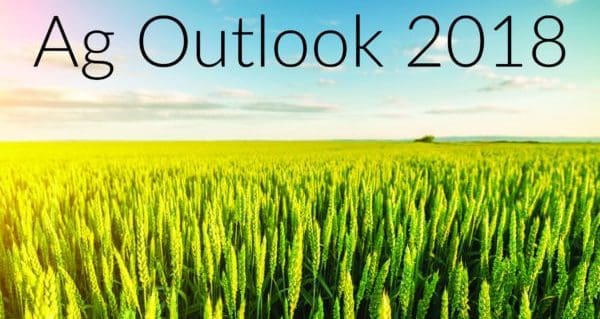Kenneth Brown
of The Clarion
Producers from across the region are preparing for the growing season after having heard from experts at the 2018 West Central Ag Outlook.
The Ag Outlook meeting took place on March 14 at the Elks Hall in Kindersley. Approximately 150 people were in attendance to hear from four agriculture experts. The event is sponsored each year by a large group of businesses from Kindersley and area.
Thirty businesses and Saskatchewan Agriculture sponsored the 2018 West Central Ag Outlook. Aside from experts, the event has a complimentary lunch, agriculture exhibitors and a chance to win a door prize of $500 in Ag Outlook Bucks to spend at the sponsoring businesses.

John Ippolito
The speakers at this year’s event included John Ippolito, a crop specialist at Saskatchewan Agriculture, Jonathon Driedger, a FarmLink market analyst out of Winnipeg, Clark Brenzil, a weed control specialist at Saskatchewan Agriculture, and Drew Lerner, a popular farm weather expert with World Weather Inc.
[emember_protected for=”2″ custom_msg=’For more on this story, please see the Mar. 23 print edition of The Cross Roads.’]
Ippolito went first and the crop specialist spoke about insects and diseases. The expert had more good news than bad news when it came to insects. He told producers the ministry has an interesting forecast for pests.
He noted that the ministry is forecasting one of the lowest infestations across the province for wheat midge and grasshoppers, so it is good news for growers. Ippolito also spoke about the Diamondback Moth because the pest was a problem in 2017 and there were no other major pest concerns for 2018.
The expert said the ministry had a “significant” amount of control for the moth and producers have been asking about the pest, but it is not easy to predict because they winter in the southern United States and they only end up in Canada if the wind blows in the right direction.
As for diseases, he said root rot complexes in pulse crops have become a concern for growers in west central Saskatchewan. The root rot pathogens are in the fields whether it is a wet growing season or not, but a water mold pathogen will be present in a wet season. He noted that growers did not have to worry much about Fusarium during a dry 2017 growing season, but they now have to worry about another root-based disease.
“This is the first year where we’ve actually club root in commercial fields in Saskatchewan,” Ippolito said, recognizing the ministry is trying to raise awareness because club root is not only in Alberta. “We found that in 2017.”

Jonathon Driedger
Driedger spoke next about the market outlook. A flat market for agriculture commodities was a common theme in the expert’s presentation. He opened his presentation on wheat markets and he said the world’s wheat stocks are high, so the price is anticipated to stay flat amid a buyer’s market.
Weather is the biggest factor and the most unpredictable variable, but wheat stocks are likely to stay high assuming normal weather for wheat growing regions in 2018. Dreidger said the hard red winter wheat belt in the United States is an area to watch for drought.
The picture is similar for durum wheat. The world’s stocks are still high, so he predicts a flat market. The durum market has new competition now with Iran exporting durum and although it is not a large exporter, it still takes away from Canada’s market share in places including Africa.
Driedger said the pulse crop situation is not improving due to the political climate in India and its import tariffs. He noted that “it’s a bit of a mess” in India because even people there believe the tariffs are bad policy.
The expert was in India recently and people in India know the country’s pulse crop industry cannot feed the whole country, so the country will have to rely on imports at some point in the future. He told producers that he does not expect India to relax its import tariffs until after the country’s next election in 2019.
“Those markets will eventually pry themselves open again,” Driedger said, recognizing that he does not expect market prices for pulses to improve in the immediate future and producers might want to keep it in mind going forward.
He noted that there is a wider market for green lentils, so there is more demand for green lentils than for red lentils. He said red lentils and yellow peas are sensitive to India, so they are not doing well and he expects green pea acres to remain flat in Canada.

Clark Brenzil
Although the canola market has softened, canola is still expected to do well in 2018 while most all of the other commodities are anticipated to remain flat, he added.
Brenzil was a late addition to the Ag Outlook because David Yee, a precision technology expert, had to cancel his appearance. Brenzil’s presentation focused on herbicide resistance in fields across Saskatchewan.
The weed control specialist spoke about resistance across a wide range of herbicide groups. He told producers about how herbicide resistant weeds spread within fields or from field to field. The expert presented a range of statistics about both grass and broad leaf weed varieties.
He noted that sanitation, crop rotation including the integration of forages into the rotation, crop practices such as adjusting seeding rates, integrated crop management, bio-controls and herbicide layering could help. Growers in Australia are now using chaff decks on combines to control the spread of resistant weeds, Brenzil added.
Lerner has always been the final speaker for Ag Outlook. The prairie farm weather expert said there is currently a lot of contrast around the prairies with respect to weather and moisture levels in the fields. He said there is a “pitiful” amount of moisture in subsoil.
He noted that 2017 was a dry year for the prairies due to a combination of an elongated high pressure ridge and low ocean temperatures. Colder ocean temperatures mean less moisture and fewer water particles in the atmosphere.

Drew Lerner
Warmer ocean temperatures started to build up in February, and Lerner said it is going to help create low pressure systems that should result in moisture. He said the more severe storm systems are expected to hit certain prairie regions, so it could mean more moisture for parts of west central Saskatchewan.
Lerner said there is still a lingering La Nina affect, so he spoke about the impacts of a slight La Nina combined with the solar cycle and the 18-year weather cycle that he will use to help forecast weather for the growing season.
The expert said he does not expect much moisture for the west central region early in the season. He told producers the prairies are going to remain under a high pressure ridge, so he expects a dryer bias for much of the season, which is not ideal with low subsoil moisture. He added that he does not expect all-out drought conditions for the area, but he predicted a dry bias through the growing season.

